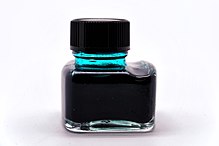Fountain pen ink
Pigment-based inks (which contain solid pigment particles in a liquid suspension) tend to clog the narrow passages of the pen.
They have the advantage of being waterproof and are used by artists who want to draw lines that will not be affected by a watercolour wash.[3] The ideal fountain pen ink is free-flowing, free of sediment, and non-corrosive.
[5] Iron gall ink was used in fountain pens when they were invented but has the disadvantage of causing corrosion to metal parts.
In addition to water, the non-dye components (collectively referred to as the vehicle) might include polymeric resins, humectants to retard premature drying, pH modifiers, anti-foaming agents, biocides to prevent fungal and bacterial growth,[6] and wetting agents (surfactants).
Care must be taken when using some vintage pens manufactured from celluloid, as this material can become stained by long-term exposure to some inks.
In the late 20th century, particular attention has been paid by ink manufacturers to the durability of their products against the effects of time, light, moisture, and efforts at forgery or falsification[10] (see Check washing).
[10] Other inks use dyes that chemically bond with the paper's cellulose, and which likewise resist removal by solvents.
A disadvantage of the dye inks is that, if spilled, they will form irremovable stains on clothing made from cotton, which also contains cellulose.





